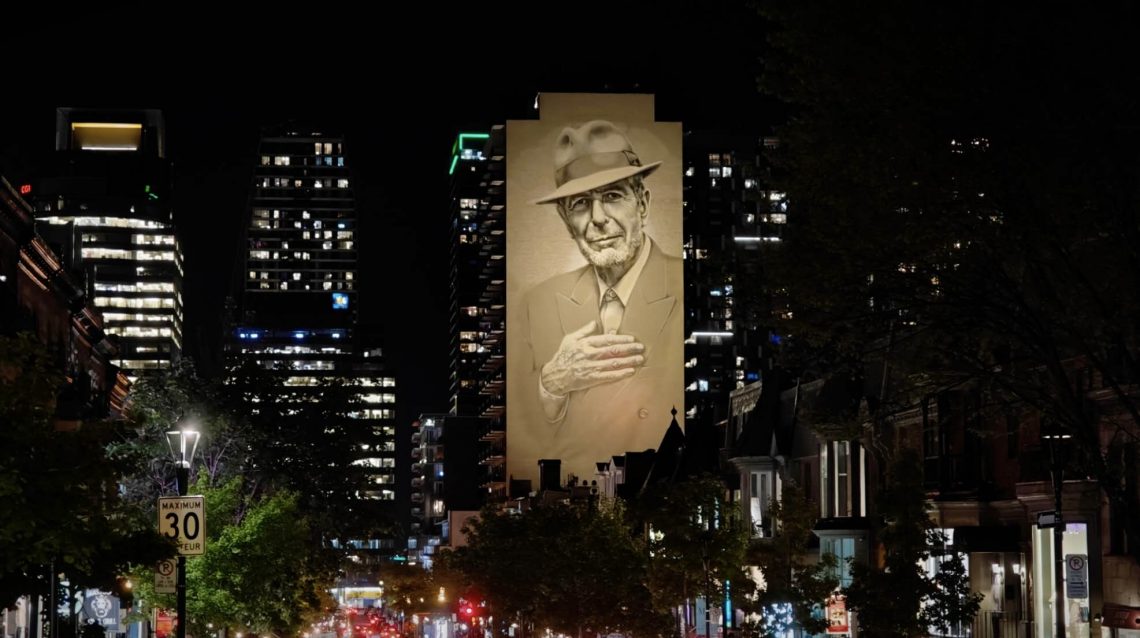
蒙特利尔随笔 | Montreal Notes

蒙特利尔给我的第一印象是很像曼彻斯特,或许是因为我刚到这的前两天一直在下雨。
但事实上,蒙特利尔很难归类,她不像任何地方。她不像北美,这里的人们说着法语,城市装扮精致;她不像法国,这里没有刻意的优雅,人们随和亲切;她不像英国,这里的街道宽敞,种族多元。
当我一路听着Leonard Cohen的歌,穿过麦吉尔大学,爬上皇家山的观景平台,在这里远眺城市,这里的天际线多少还是有些让我吃惊。城市整洁,很多处建筑有壁画,高楼鳞次栉比。河网密布,没有建筑的地方都是绿色。
直到到这里的第三天,起床后终于引来了大晴天,但当我出门转了一会后,这里的雨又开始下了起来。雨中没有带伞的人们的眼神并不匆忙,应该是已经习惯了这里的阴晴多变。
蒙特利尔的雨很美,这里的雨天比晴天更美。风卷着绿色的枫叶落下,大颗大颗的雨滴随后也落了下来。太阳离开以后,天气会骤然凉了起来,但不算冷。
这几天我并没有花太多时间去蒙特利尔城市探索,只是在麦吉尔大学附近以及我所住的酒店反复穿梭。
一方面,是因为我实在太疲惫了。上周我在柏林出差,周四刚回到杭州,周五又启程飞往蒙特利尔。短短两周内,我在多哈机场中转了四次,每次行程都超过24小时,也算是极限挑战了。
另一方面,我也希望能和这所大学、这座城市建立起一种“日常的关系”。上周在柏林的周日,我用一整天时间密集地city walk,刷了三个博物馆和一个勃兰登堡门,虽然满足了打卡的快感,却少了一些观察和感受的空间。这也是我不太喜欢“特种兵式”旅游的原因:走得越多,越觉得“到此一游”并无法留下太多实质性的东西。
在柏林的后几天,我住在公司附近的一家小旅馆,每天沿着同一条路步行二十分钟上下班,见到相似的街道和人群,下班后去固定的小餐馆吃kebab。尽管只待了几天,我却感到和这座城市之间建立了某种连接。回国后我和家属说,感觉这不是我第一次来柏林,我仿佛早已熟悉了它。这也让我意识到,正是“日常”让人和一座城市产生了真正的关系。
所以在蒙特利尔,我并没有开很多的地图,我想深度优先取代广度优先。每天早晨睡到自然醒,吃一顿饱饱的早餐,然后就自然而然地去学校逛一逛。
麦吉尔大学很美。
这是一座与城市连接得很紧密的学校。它就在皇家山脚下的一个斜面上,面朝这蒙特利尔城市的高楼大厦。校园里每一栋建筑看上去都很古朴典雅,而每一栋建筑的内部都经过精心设计,校园的公共空间也同样充满巧思。每到天气晴朗的午后,校园里总有三三两两的年轻人坐在草地或长椅上,有的对着电脑,有的安静地读书,宁静得像一幅画。
虽然我说蒙特利尔不像任何一座城市,但这里与北美的共性依然明显,那就是不论是美国还是加拿大,都是移民国家,他们的历史很苍白。苍白到我对北美的人文建筑比如广场、公园、教堂都没有太大兴趣。加拿大1867年才正式建国,在建国之前,这里是英国的一个省。本来法国人率先在这里殖民。1763年,法国因多年战争战败,将这片殖民地割让给英国,这里成了英国的一个省。不管是英国还是法国本土,他们的很多建筑都是历史性事件的发生地。而加拿大,这里的城市从来没有成为过历史舞台的中心。所以说实话,我对加拿大的人文历史并不感兴趣。
蒙特利尔与欧洲的共性也还是很多的,这里城市里的房子有花园的很少,都是欧洲式的在街道两边排列整齐民居,有的还有欧洲的那种小阳台。这里满大街也都是vespa,这一点和欧洲一样。有一点比较特别的是,蒙特利尔的建筑壁画特别多,不是随意的涂鸦,而是颇具艺术感的作品,颇有点国内农村房屋壁画的感觉,只不过更洋气更艺术。
这几天我常会去麦吉尔大学的学生Lounge坐一坐,每次去,总有同学不经意地坐在钢琴前弹奏起旋律,非常优美。Lounge的环境非常好,伴着这些旋律,让人感叹这真是一所既好又有格调的学校。在这里的这段时光让我想起了11年前在美国内布拉斯加的那个夏天。我住在哥哥姐姐家,每天往返于社区与内布拉斯加大学林肯分校的图书馆之间。现在想想,那段看似无聊的日子却格外难忘。
蒙特利尔的音乐氛围还挺特别的。有一天晚上,我临时起意去了当地著名的爵士酒吧 Upstairs。蒙特利尔是全世界最著名的爵士乐城市之一,每年举办全球最大的爵士音乐节。城中遍布大大小小的爵士酒吧,我去的这家Upstairs,外表看很不起眼,但是当地最有名气的爵士乐酒吧之一。酒吧虽然里面面积不大,大家坐的都很近,但是很有氛围。当晚在酒吧演奏的乐队正是来自于麦吉尔大学,吉他手的硕士专业正是爵士乐表演专业。这只乐队非常多元化,键盘手来自美国,贝斯来自于巴西,鼓手来自于魁北克,而吉他手来自于哥伦比亚。
当晚有三场演出,我赶上了后面的两场。一共点了三杯啤酒,perona和ipa。这只乐队演出很专业,鼓手很出彩,演出过程中酒吧里的大部分人都把注意力放在演出上,大家都看的很尽兴。当晚的这段经历,让我不由想起皮克斯的动画片《心灵奇旅》(soul),主人公就是教爵士乐手,我喜欢爵士乐应该也是从这部电影开始。“Jazzing”不是一个正式的英文词汇,但电影里的22号灵魂因为不谙世事,发明了这个词汇。主人公最后借用了这个词汇,对22号说:“You are pretty good at Jazzing”。
Jazzing 在我看来就是爵士精神,它超出了爵士乐本身,是随性、即兴、享受当下的代名词。蒙特利尔之所以爵士乐盛行,我觉得也是与这座城市性格和爵士乐性格很搭的原因。蒙特利尔适合没有野心的人。它曾经在上世纪七十年代举办过奥运会,但也正因为此累计了巨额债务,从此城市一蹶不振,逐渐被多伦多超过。现在的蒙特利尔偏居在法语区,城市节奏悠闲,似乎处于怡然自得的状态。在工作日的下午,我穿过城市街道去买贝果,路过皇家山脚下的公园,满眼都是在草坪上享受阳光的人们。有的人打沙滩排球,有的人玩飞盘,更多的是三三两两坐在草坪上闲聊的说着法语的人们。经历过历史起伏,这座城市自洽地回归到了爵士精神。
那天晚上离开Upstairs后,已经是十点半了,我穿过街道走回酒店。接近午夜的蒙特利尔还是灯火通明,街道上人群很多,这是一座有夜生活的城市。穿过一个十字街道时,我扭头一看,惊讶地发现巨幅Leonard Cohen的壁画就在我面前。城市还特意为这面壁画做了灯光装置,让它夜里格外醒目。Cohen是麦吉尔大学的校友,也是蒙特利尔城市的骄傲。他在2016年去世,去世前还发行了最后一首歌,叫You want it darker,这是他写给世界的诀别信,歌曲的最后一句歌词是:I’m ready, my lord..
穿过Cohen壁画没多久,就来到了麦吉尔大学校园。这次我来蒙特利尔,就是为了参加麦吉尔大学的毕业典礼的。我在这里获得了管理学硕士的学位,这也是我自己的骄傲。虽然我未曾来到过这个校园,麦吉尔会把教授送到浙大给我们上课,但我仿佛对这个校园已然非常熟悉。虽然已经到了晚上11点,校园里面还是有不少的人。麦吉尔大学和蒙特利尔城市完全融合在一起,校园也是蒙特利尔城市景观的一部分,很美。
晚上的Arts Building还亮着灯,这个建筑是麦吉尔大学的地标性建筑。当天晚上天空晴朗,可以看到很多星星,而北斗七星就挂在校园的正上方。我抬起头看星星,两个中国留学生过来问我在看什么,我指给他们看北斗七星。他们也很惊喜地和我一起看,原来他们也不曾留意到北斗七星会在这个时节挂在校园的正上空。
后面有一天出去和同学聚餐,结束以后与在这里交换的同学一起走路回酒店,他们惊讶地问我:这真的是你第一次来麦吉尔吗?感觉你好像对这里已经很熟悉了。我觉得应该是吧,这篇文稿就是在麦吉尔大学的图书馆里完成的,窗外的蒙特利尔又开始下起了小雨,而远处的阳光还很灿烂,我好像不是第一次来到这里。
很开心在人生这个节点,来到了麦吉尔,收获了一个新的学位;但更让我开心的是,我遇见了蒙特利尔这座城市。她告诉我,生活,其实可以这样过。



